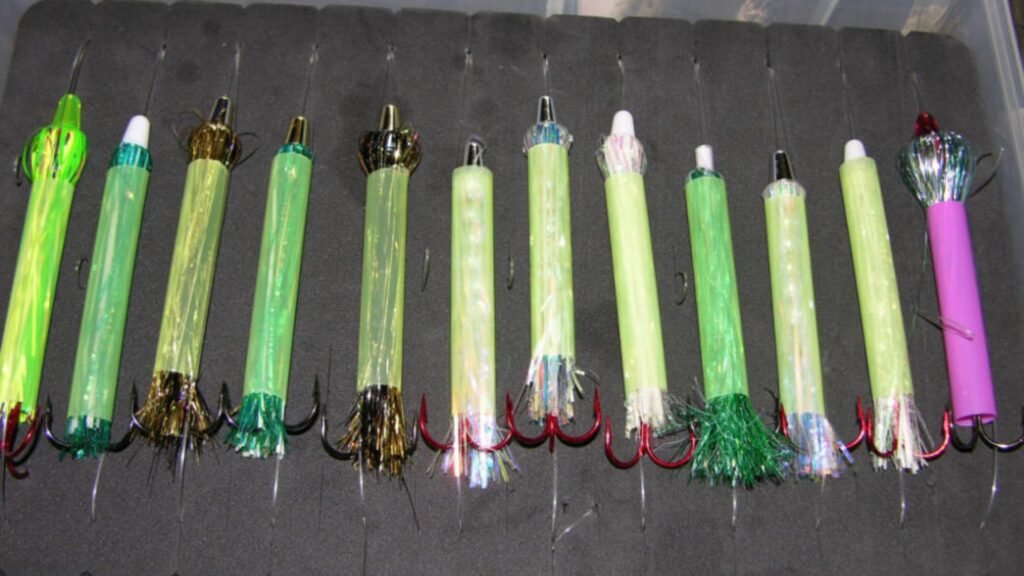Salmon fly fishing is an art that combines skill, patience, and an understanding of the behavior and environment of salmon. One of the most critical aspects of this art is selecting the right colors and materials for your salmon flies. This guide will explore how these elements play a vital role in creating effective salmon flies that can increase your chances of a successful catch.

The Role of Colors and Materials in Effective Salmon Flies
Importance of Colors in Salmon Flies
- Visibility
- Bright Colors: In murky or dark waters, bright colors like orange, yellow, and chartreuse can make flies more visible to salmon.
- Dull Colors: In clear waters, more natural colors like olive, brown, and black blend in with the environment and appear more realistic to the fish.
- Mimicking Prey
- Match the Hatch: Choosing colors that mimic the local prey can make your fly more attractive to salmon.
- Seasonal Changes: The color of prey can change with seasons, so adjusting your fly colors accordingly can be beneficial.
- Behavioral Triggers
- Aggressive Response: Bright and flashy colors can sometimes trigger an aggressive response from salmon, making them strike out of territoriality rather than hunger.
- Curiosity: Unique color combinations can intrigue salmon, making them more likely to investigate and bite.
Key Materials for Salmon Flies
- Feathers
- Hackle Feathers: Used for creating legs and movement in the water.
- Marabou Feathers: Soft and flowing, ideal for creating a lifelike movement.
- Pheasant Tail Feathers: Commonly used for tails and wings due to their durability and realistic appearance.
- Fur and Hair
- Bucktail: Stiff hair used for wings and tails, adding buoyancy and movement.
- Rabbit Fur: Soft and versatile, perfect for bodies and tails.
- Squirrel Tail: Adds natural color and texture to flies.
- Synthetics
- Flashabou and Tinsel: Adds sparkle and flash to attract salmon, especially in low-light conditions.
- Synthetic Dubbing: Used for bodies, offering a wide range of colors and textures.
- Rubber Legs: Adds realistic movement and durability.
- Threads and Wires
- Thread: Used to bind materials together, available in various colors to match or contrast with the fly.
- Wire: Adds weight and segmentation, making flies more durable and realistic.
Choosing the Right Combination
- Water Conditions
- Clear Water: Use natural colors and lightweight materials to create a subtle and realistic appearance.
- Murky Water: Opt for bright colors and flashy materials to enhance visibility.
- Light Conditions
- Bright Days: Natural and muted colors work best to avoid spooking fish.
- Cloudy or Low Light: Bright and reflective materials can help attract salmon.
- Behavior of Salmon
- Aggressive Fish: Use bold and contrasting colors with lots of movement.
- Finicky Fish: Stick to natural colors and subtle patterns.
Popular Salmon Fly Patterns
- The Green Highlander
- Colors: Green, yellow, and orange.
- Materials: Peacock herl, golden pheasant crest, and tinsel.
- The Blue Charm
- Colors: Blue and silver.
- Materials: Blue squirrel tail, silver tinsel, and black hackle.
- The Silver Doctor
- Colors: Silver, red, and blue.
- Materials: Silver tinsel, blue guinea fowl feathers, and red floss.
- The Sunray Shadow
- Colors: Black and silver.
- Materials: Black squirrel tail, silver body, and synthetic wing.
Tips for Tying Effective Salmon Flies
- Balance and Proportion
- Ensure the fly is well-proportioned and balanced to swim correctly in the water.
- Durability
- Use strong, durable materials that can withstand repeated strikes and tough water conditions.
- Experimentation
- Don’t be afraid to experiment with different color combinations and materials to find what works best in your local waters.
Conclusion
The colors and materials used in salmon flies play a crucial role in their effectiveness. By understanding how these elements impact visibility, mimic prey, and trigger behavioral responses, anglers can create flies that significantly improve their chances of catching salmon. Whether you are a beginner or an experienced fly tier, paying attention to the details of color and material selection will enhance your success on the water.



